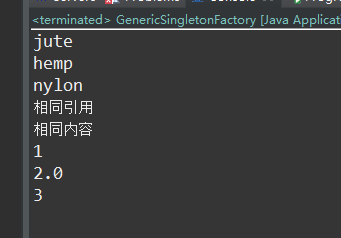package cn.xf.cp.ch02.item27; import java.util.HashSet; import java.util.Set; public class Union { /** * 这个方法就会有警告 * @param s1 * @param s2 * @return */ public static Set union1(Set s1, Set s2) { Set result = new HashSet(s1); result.addAll(s2); return result; } /** * 这里使用泛型就是安全没有警告的 * @param s1 * @param s2 * @return */ public static <E> Set<E> union(Set<E> s1, Set<E> s2) { Set<E> result = new HashSet<E>(s1); result.addAll(s2); return result; } }
但是有的时候,我们发现使用泛型的时候,在调用构造器的时候要明确泛型的类型,这样书写很麻烦
这里可以使用一个泛型静态方法,利用泛型的类型推导
package cn.xf.cp.ch02.item27; import java.util.HashMap; import java.util.List; import java.util.Map; public class GenericStaticFactory { public static <K, V> HashMap<K, V> newHashMap() { return new HashMap<K, V>(); } public static void main(String[] args) { //这里创建对象的时候,就会根据前面map中的String和List<String>自动转换 Map<String, List<String>> anagrams = newHashMap(); } }
关于泛型单利工厂的实现
package cn.xf.cp.ch02.item27; public class GenericSingletonFactory { //先创建object对象,暂时替代T对象 private static UnaryFunction<Object> IDENTITY_FUNCTION = new UnaryFunction<Object>() { public Object apply(Object arg) { return arg; } }; //根据T,吧IDENTITY_FUNCTION转换为相应的类型,由于IDENTITY_FUNCTION返回未被修改的object类型参数,所以下面类型转换时安全的 @SuppressWarnings("unchecked") public static <T> UnaryFunction<T> identityFunction() { return (UnaryFunction<T>) IDENTITY_FUNCTION; } public static void main(String[] args) { String[] strings = { "jute", "hemp", "nylon" }; UnaryFunction<String> sameString = identityFunction(); for (String s : strings) System.out.println(sameString.apply(s)); Number[] numbers = { 1, 2.0, 3L }; UnaryFunction<Number> sameNumber = identityFunction(); //这里用来判断是否真的实现了单例 Object t1 = sameString; Object t2 = sameNumber; if(t1 == t2) { System.out.println("相同引用"); } String s1 = "123456"; String s2 = new String("123456"); if(s1.equals(s2)) System.out.println("相同内容"); for (Number n : numbers) System.out.println(sameNumber.apply(n)); } }
显示结果:
